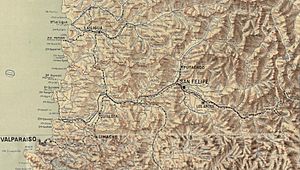Aconcagua mummy facts for kids
The Aconcagua mummy is the well-preserved body of a seven-year-old boy. He was part of an ancient Inca ritual called capacocha. Scientists believe he lived around 1500 AD. His body stayed frozen and well-preserved because of the very cold and dry conditions. He was found high up on a mountain. Hikers discovered him in 1985 on Aconcagua mountain in Mendoza, Argentina. This mountain is very tall, about 5,300 m (17,400 ft) high.
Finding the Mummy
In 1985, some mountain climbers made an amazing discovery. They found the Aconcagua mummy at the bottom of Pirámide Mountain. This mountain is part of the larger Aconcagua Mountain. When they found the body, the hikers quickly contacted local authorities. This allowed experts to come and carefully dig up the mummy.
The Capacocha Ritual
The Capacocha was a special and important ritual in the Inca Empire. It involved the ceremonial offering of young boys and girls. The Inca people believed that children chosen for this ritual were very special. They were seen as the calmest and most pure children in the empire. This made them worthy of being offered to the gods.
For a year before the ritual, these chosen children received the best food. Their diet mainly included maize (corn) and charqui, which was dried llama meat. Many parents felt sad about giving up their children. However, they were not allowed to show their sadness during the ceremony. Other parents felt it was a great honor for their child to be chosen. Some even offered their own children to the gods.
Each child was often buried with many different items. These items, called grave goods, were offerings to the gods. The types of goods buried with the children depended on how important the burial site was. Sometimes, even animals were buried alongside the children.
What DNA Tells Us
Scientists have studied the Aconcagua mummy's DNA to learn more about him. In 2015, they took a tiny sample from one of his lungs. They looked at his mitochondrial DNA (mtDNA). This type of DNA is passed down from mothers. They found a new group of mtDNA called C1bi. The "i" stands for Inca. This C1bi group has 10 unique changes compared to other C1b groups. Researchers think this C1bi group first appeared about 14,300 years ago. They even found a match for this group in an ancient person from the Wari Empire.
In 2018, scientists studied more of the mummy's DNA, this time from his Y-chromosome. This DNA is passed down from fathers. His Y-DNA belongs to a group called Haplogroup Q-M3. His specific Y-DNA group is very similar to the Choppca people. They are a Quechua-speaking group from Huancavelica. The mummy's DNA is more like modern Quechua-speaking people than Aymara-speaking people. Overall, the Aconcagua mummy's DNA is very similar to people living in the Andes mountains today.


